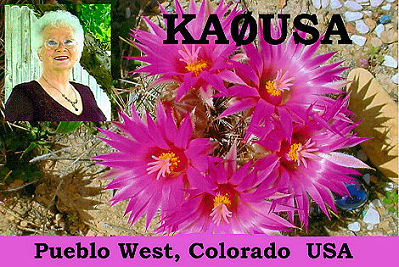|
KA0USA's Activities
I'm proud of the performance from the tape measure
antenna yagi I built in 2010 as part of a club project geared toward
hidden transmitter hunting. I did most of the work myself, The antenna shows good a front to back ratio and side signal rejection. Signal readings from the Colorado Connection's 145.130 repeater showed an S9+20 db (the highest the meter will show on our rig) with the antenna pointed at it, an S4 reading off the back of the antenna, and S0 (just noise) off the side of the antenna. The original space between the driven elements was 1". We did tweak the SWR just a bit by decreasing the distance between the driven elements by 3/16", but as built, the antenna was okay for use as a transmit antenna as well. The length of the driven element could be shortened just a bit more, but it is quite usable as is. The SWR at 144 MHz was slightly over 1.3:1 at 144 MHz, less than 1.2:1 at 145.5 Megs, and less than 1.7:1 at 148 MHz. Any further tuning will be done by trimming the ends of each of the driven elements 1/16" at a time. No adjustment was made to the 6" hairpin match made from uninsulated #14 solid copper wire. RG-58 was used to connect the antenna to an Realistic (Radio Shack) HTX-202 handheld.
I decided to try out the yagi and see if I could hear
the International Space Station. After deciding the crew wasn't going
to make any voice contacts on 145.800 Mhz on the pass, I switched to
the ISS APRS frequency of 145.825 Mhz. By this time, the space
station was approaching its peak elevation. The antenna did much
better than expected. I was able to track the ISS Later, Bill added an MFJ-762 attenuator to the antenna. This added up to 81 dB of attenuation, allowing me to get closer to the transmitter before the handheld overloads. In January 2011, Bill and I attended Quartzfest, an annual gathering of amateur radio operators in the desert south of Quartzsite, AZ. While there, I participated in a hidden transmitter hunt. I found three of the four transmitters and was within a few feet of the fourth when it was found. |


 including
cutting the PVC pipe with a chop saw and tinning the driven
elements. The tape measure used for the elements was purchased for
$1.99 at Harbor Freight. Six muffler clamps were used to attach the
elements, rather than using screws to attach them to the PVC
fittings. The ends of each element were covered with electrical tape.
The PVC fittings are bolted to the boom, so the antenna may be broken
down for travel or storage.
including
cutting the PVC pipe with a chop saw and tinning the driven
elements. The tape measure used for the elements was purchased for
$1.99 at Harbor Freight. Six muffler clamps were used to attach the
elements, rather than using screws to attach them to the PVC
fittings. The ends of each element were covered with electrical tape.
The PVC fittings are bolted to the boom, so the antenna may be broken
down for travel or storage. right
down to the horizon on a handheld radio. Until it was down to about
10 degrees above the horizon, signals were at full scale. I was able
to track the station to within a few seconds of the posted Loss of
Signal (LOS).
right
down to the horizon on a handheld radio. Until it was down to about
10 degrees above the horizon, signals were at full scale. I was able
to track the station to within a few seconds of the posted Loss of
Signal (LOS).